April 16, 2010

This article discusses the introduction of garden furniture in the 18th century, which was fueled by the new view of the garden as an outdoor living area, and notes the evolution from wooden furniture to wrought-iron pieces. It originally appeared in the June 1941 issue of American Collector magazine, a publication which ran from 1933-1948 and served antiques collectors and dealers.
An Englishman’s house may be his castle, but his garden has long been first in his affections. In fact, according to John Parkinson who laid down the principles of garden planning in the early 17th Century, the very location of the house was contingent on the benefits that might accrue to the garden.
“The house,” he stated, … (continue reading)

This article discusses the life and craft of Jacob Bachman and his family and compares his work to that made by other notable craftsmen in the 16th and 17th centuries. It originally appeared in the October 1945 issue of American Collector magazine, a publication which ran from 1933-1948 and served antiques collectors and dealers.
For a considerable number of years, the discriminating antiques collectors of Lancaster, Pennsylvania, have noted the occasional appearance of a secretary desk, … (continue reading)
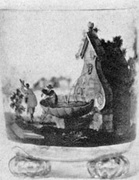
This article discusses hausmaler, individual German painters who worked on fayence or porcelain, noting some specific artists and their designs. It originally appeared in the November 1945 issue of American Collector magazine, a publication which ran from 1933-1948 and served antiques collectors and dealers.
This is a province of Germanic art not known to many of us. If there are no awe inspiring peaks and no big rushing streams it is nevertheless a pleasant landscape. Of course … (continue reading)

This article on pepper shakers discusses the materials used, the various design patterns, and the value of pepper in 16th century, describing some specific examples of pepper pots. It originally appeared in the August 1941 issue of American Collector magazine, a publication which ran from 1933-1948 and served antiques collectors and dealers.
Early American pepper pots, or casters, or muffineers (and they are all one) present an elusive quest. But their charm is great and their history … (continue reading)

This article describes how to determine whether a piece of porcelain is hard- or soft-paste, noting the differences between items produced by a wide range of potteries throughout the world. It originally appeared as a two-part series in the January and February 1942 issues of American Collector magazine, a publication which ran from 1933-1948 and served antiques collectors and dealers.
Illogical though it may seem, few of the thousands of American china collectors know how to distinguish between … (continue reading)

This article discusses the life and work of Heinrich Wilhelm Stiegel, noting his experiences working in the iron business, his switch to glass, and his eventual bankruptcy. It originally appeared in the November 1937 issue of American Collector magazine, a publication which ran from 1933-1948 and served antiques collectors and dealers.
The average collector is apt to think of Stiegel only in connection with his glass and the apocryphal stories about … (continue reading)

This article describes cup plates commemorating various important figures in U.S. history, such as Major Ringgold, George Washington, Henry Clay, and William Henry Harrison, noting why each was worthy of being featured on the plates. It originally appeared in the October 1948 issue of American Collector magazine, a publication which ran from 1933-1948 and served antiques collectors and dealers.
Over the years since collecting cup plates became a diverting hobby, it was natural that they should have … (continue reading)
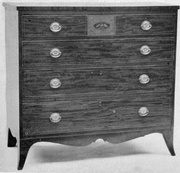
This article discusses the characteristics of the Hepplewhite furniture design style, comparing it to other styles, and notes the limited information available about George Hepplewhite and his wife, Alice. It originally appeared in the February 1938 issue of American Collector magazine, a publication which ran from 1933-1948 and served antiques collectors and dealers.
Great as was the impact of the Hepplewhite style on furniture design in both Great Britain and America during the last 15 or … (continue reading)

This article discusses William Faris’ life, his family relationships, and his clocks and silver work, describing some silver spoons that have his mark. It originally appeared in the February 1948 issue of American Collector magazine, a publication which ran from 1933-1948 and served antiques collectors and dealers.
The most picturesque figure among the 18th century Maryland silversmiths was William Faris of Annapolis, watch maker, clockmaker, silversmith, designer, portrait painter, cabinetmaker, mirror maker, tulip grower, tavern keeper, dentist, … (continue reading)
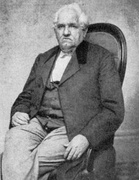
This article discusses the life, craft, and partnerships of Massachusetts clockmaker Daniel Pratt. It originally appeared in the January 1948 issue of American Collector magazine, a publication which ran from 1933-1948 and served antiques collectors and dealers.
Daniel Pratt, Jr., clockmaker, banker, town clerk, legislator, was in present parlance a “solid citizen” of the town of Reading, Massachusetts, in the middle 1800s. Reading is a pleasant suburb twelve miles north of Boston. For that part of the State, … (continue reading)
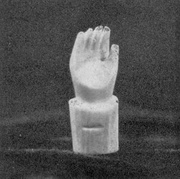
This article focuses on the hand motif, discussing how the positioning of the hand and fingers can represent different meanings and providing some examples. It originally appeared in the November 1945 issue of American Collector magazine, a publication which ran from 1933-1948 and served antiques collectors and dealers.
The human hand has been used for centuries as a decorative motif. We find it made of china, ivory, glass, precious metals, coral; in fact, from nearly every material … (continue reading)

This article discusses the Chippendale furniture design style, noting its characteristics and some of the adaptations that were made, and describing the three main types of furniture (case pieces, tables, and chairs) and the different variations of each. It originally appeared in the December 1947 issue of American Collector magazine, a publication which ran from 1933-1948 and served antiques collectors and dealers.
Thomas Chippendale lived in the London of great artists whose names are indelibly associated with … (continue reading)
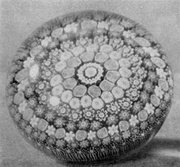
A Comparative Study of Design and Craftsmanship
This article discusses the history of glass paperweights, from their original designs and production processes to their spread across the world, noting some of the major manufacturers and design styles. It originally appeared as a two-part series in the February and March 1942 issues of American Collector magazine, a publication which ran from 1933-1948 and served antiques collectors and dealers.
Part I:
(Editor’s Note: Although glass paperweights have been collected in the United States … (continue reading)

This article discusses glass produced in late 19th century, describing popular patterns, types of glass, and notable innovations (such as pressed and Amberina glass). It originally appeared in the November 1947 issue of American Collector magazine, a publication which ran from 1933-1948 and served antiques collectors and dealers.
The sweeping tendency to dismiss all American glass manufactured after 1850 as a cheap commercial product is passing out of fashion. Articles and books on the subject are partially … (continue reading)
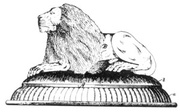
This article discusses the animals featured on Thomas B. Atterbury’s glassware, describing the pictured designs and quoting his patents. It originally appeared in the October 1945 issue of American Collector magazine, a publication which ran from 1933-1948 and served antiques collectors and dealers.
While doing research work in the Pittsburgh, Pennsylvania, area in 1933, it was my privilege to interview a large number of officials connected with glass companies, as well as actual glassworkers. It was … (continue reading)















 Music of the Presses: How an L.A. Printer Kept the Art of the Album Cover Alive
Music of the Presses: How an L.A. Printer Kept the Art of the Album Cover Alive Bloodletting, Bone Brushes, and Tooth Keys: White-Knuckle Adventures in Early Dentistry
Bloodletting, Bone Brushes, and Tooth Keys: White-Knuckle Adventures in Early Dentistry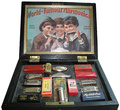 How a Gang of Harmonica Geeks Saved the Soul of the Blues Harp
How a Gang of Harmonica Geeks Saved the Soul of the Blues Harp The Waiting Game: What It Really Takes to Get on 'Antiques Roadshow'
The Waiting Game: What It Really Takes to Get on 'Antiques Roadshow' In Pursuit of the Great American Jean
In Pursuit of the Great American Jean Mari Tepper: Laying it on the Line
Mari Tepper: Laying it on the Line Nice Ice: Valerie Hammond on the Genteel Charm of Vintage Canadian Costume Jewelry
Nice Ice: Valerie Hammond on the Genteel Charm of Vintage Canadian Costume Jewelry How Jim Heimann Got Crazy for California Architecture
How Jim Heimann Got Crazy for California Architecture Modernist Man: Jock Peters May Be the Most Influential Architect You've Never Heard Of
Modernist Man: Jock Peters May Be the Most Influential Architect You've Never Heard Of Meet Cute: Were Kokeshi Dolls the Models for Hello Kitty, Pokemon, and Be@rbrick?
Meet Cute: Were Kokeshi Dolls the Models for Hello Kitty, Pokemon, and Be@rbrick? When the King of Comedy Posters Set His Surreal Sights on the World of Rock 'n' Roll
When the King of Comedy Posters Set His Surreal Sights on the World of Rock 'n' Roll How One Artist Makes New Art From Old Coloring Books and Found Photos
How One Artist Makes New Art From Old Coloring Books and Found Photos Say Cheese! How Bad Photography Has Changed Our Definition of Good Pictures
Say Cheese! How Bad Photography Has Changed Our Definition of Good Pictures Middle Earthenware: One Family's Quest to Reclaim Its Place in British Pottery History
Middle Earthenware: One Family's Quest to Reclaim Its Place in British Pottery History Fancy Fowl: How an Evil Sea Captain and a Beloved Queen Made the World Crave KFC
Fancy Fowl: How an Evil Sea Captain and a Beloved Queen Made the World Crave KFC